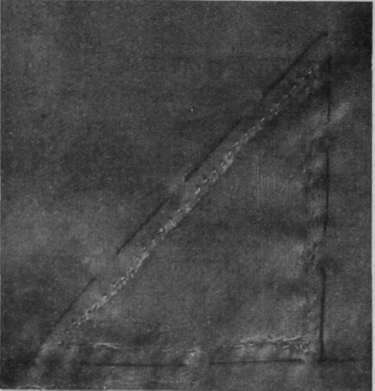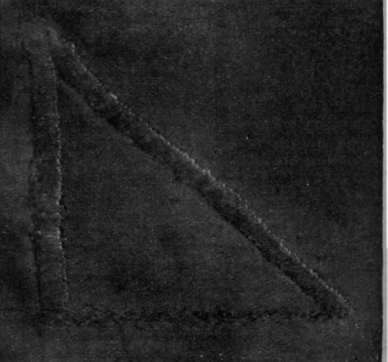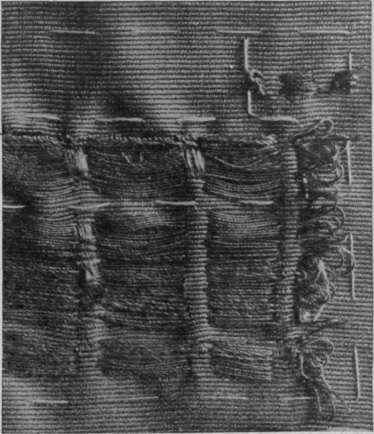The Darning Of Silk
Description
This section is from "Every Woman's Encyclopaedia". Also available from Amazon: Every Woman's Encyclopaedia.
The Darning Of Silk
How to Mend Bad Tears in Fine Silk - A Three-sided Patch - Stitches to be Used - To Prevent a Dress Wearing Out
Dad tears in fine, close-grained silk are difficult to mend invisibly, and they require much skill and patience.
Sometimes, if the damage is of very great edges of the material should be cut away in this shape. (See Fig. 1.)

Fig. 1. A jagged tear in silk can be mended best by inserting a triangular patch extent, it is better to repair it with a patch, especially if the silk is in the least rotten, or is torn out much at the edges. A three-sided patch is as neat as any, and the torn

Fig. 2. Tack the material for the patch in position, having previously trimmed the edges of the tear, and fasten down with small running stitches
The piece for the patch should be tacked in position under the hole, and the border of the silk fastened down to it with very small running stitches worked in the finest silk thread of exactly the same shade. (See Fig. 2.)
For the final fixing in place, the two upstanding sides of the triangle may be worked over with a long, flat, but quite even sewing stitch (see Fig. 3); but, if the silk will bear it, smaller stitches may be used to fasten the patch. Should the silk seem inclined to break away easily, the first-mentioned method will be by far the most satisfactory, and make the mend more durable.

Fig. 3. Work the sides of the triangle over with a long, flat, and even sewing stitch. Darn the other side very neatly backwards and forwards
The foundation silk is almost certain to be rather strained near the tear, but the long stitches will show very little if the mending silk is well matched.
The bottom side of the triangle (the line of which should run parallel with the grain of the material) may be darned very neatly backwards and forwards.
When putting in a patch, it is important to remember never to allow the stitches to cross the lines of the material. Also, the lines of the patch should adjoin exactly, and run straight with those on the original surface.
Corded silks, and those that have a definite line of pattern in the weaving, are the most satisfactory if repaired with a straight darn, and they are more easy to mend effectively than silks of a thinner and finer texture.

Fig. 4. Corded silk which has worn thin in several places and frayed
If it is possible to make the darn sufficiently substantial without cross work stitches, it will be less noticeable. As a rule, crosswork stitches can be dispensed with if the patch is lined with a piece of material. Something thin should be selected for the purpose, such as silk, or even net or chiffon, so that the mend will not appear clumsy, the colour, of course, matching the remainder of the silk.
If the silk, perhaps from hard wear, has cut through in several places (see Fig. 4), a patch should be cut sufficiently large to cover the entire area of the weakness. The damaged parts should be stretched slightly and pulled straight, and any intermediate places that are in good condition should be pinned to the background as much as possible.

Fig. 5. Showing a portion of a torn surface, with an underlying patch securely tacked in position
The outside edge of the patch should be tacked securely round the edge, and it should also be tacked from one end to the other, so that all the weak parts are closely surrounded. (See Fig. 5.)
Take a very fine darning needle and silk; insert it in the centre of one of the cords at the top of the patch. Run the silk along the cord, taking one big stitch and one small one, as in tacking. When the opposite end of the patch is reached, turn and come back again on the next cord, taking the stitches exactly in the same way, and leaving a loose loop, about a quarter of an inch in length, at each end. (See Fig. 6.) Proceed in this way until the whole of the thin place is covered. Continue to do the remaining darns in the same manner.

Fig. 6. A portion of a thin or broken piece of corded silk showing the first stage of darning. Loops of the darning silk would be left at the other end of the darn
When this part of the process is completed, pull the strands of silk quite straight by means of the loops that are left for the purpose at either end. . Then go over the whole of the darn again, and cover in the little strips that are exposed by the short under stitches. Fasten off the ends of these threads on the wrong side. Run a secure row of stitching at either end of the darn, so that all the rows are firmly fixed and caught down closely to the silk. Then cut away the loops on the right side, as depicted in Fig. 7. Damp and press the surface until it appears well absorbed into the material. (In Figs. 5, 6, and 7 half only of the portion under repair has been given, in order that the stitches may be clearly seen in the reproduction.)
If the silk is one with a rather coarse grain.
the mend may be made practically invisible by sewing over each thread with very fine silk, exactly to match the cording. This would take a long time, but it would be worth while on, say, a dress that has been worn very little, and when the tear is in a conspicuous place.

Fig. 7. A portion of a finished darn on corded silk
It is a good plan to keep watch for the appearance of thin places, and immediately they appear to sew over the weak cords in the manner described. This will often avoid a more unsightly repair at some later period, but is not difficult to do while the trouble is only small. In such a case, a thin patch, invisibly fastened on the wrong side of the garment, will give still more security against further damage. It is a great advantage to arrange a preventive of this kind under the sleeves, or in any part of the dress which will have particularly hard wear, even before it shows obvious signs of wearing into holes. One cannot say too often that a "stitch in time saves nine." It is sound advice, which loses none of its value by repetition.
Continue to:


